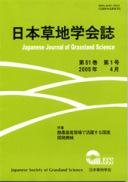Volume 20, Issue 2
Displaying 1-21 of 21 articles from this issue
- |<
- <
- 1
- >
- >|
-
Article type: Cover
1974Volume 20Issue 2 Pages Cover5-
Published: July 25, 1974
Released on J-STAGE: July 07, 2017
Download PDF (50K) -
Article type: Cover
1974Volume 20Issue 2 Pages Cover6-
Published: July 25, 1974
Released on J-STAGE: July 07, 2017
Download PDF (50K) -
Article type: Appendix
1974Volume 20Issue 2 Pages App8-
Published: July 25, 1974
Released on J-STAGE: July 07, 2017
Download PDF (42K) -
Article type: Article
1974Volume 20Issue 2 Pages 43-53
Published: July 25, 1974
Released on J-STAGE: July 07, 2017
Download PDF (1163K) -
Article type: Article
1974Volume 20Issue 2 Pages 54-60
Published: July 25, 1974
Released on J-STAGE: July 07, 2017
Download PDF (727K) -
Article type: Article
1974Volume 20Issue 2 Pages 61-68
Published: July 25, 1974
Released on J-STAGE: July 07, 2017
Download PDF (1039K) -
Article type: Article
1974Volume 20Issue 2 Pages 69-72
Published: July 25, 1974
Released on J-STAGE: July 07, 2017
Download PDF (418K) -
Article type: Article
1974Volume 20Issue 2 Pages 73-78
Published: July 25, 1974
Released on J-STAGE: July 07, 2017
Download PDF (735K) -
Article type: Article
1974Volume 20Issue 2 Pages 79-82
Published: July 25, 1974
Released on J-STAGE: July 07, 2017
Download PDF (389K) -
Article type: Article
1974Volume 20Issue 2 Pages 83-91
Published: July 25, 1974
Released on J-STAGE: July 07, 2017
Download PDF (948K) -
Article type: Article
1974Volume 20Issue 2 Pages 92-98
Published: July 25, 1974
Released on J-STAGE: July 07, 2017
Download PDF (769K) -
Article type: Article
1974Volume 20Issue 2 Pages 99-
Published: July 25, 1974
Released on J-STAGE: July 07, 2017
Download PDF (197K) -
Article type: Article
1974Volume 20Issue 2 Pages 99-
Published: July 25, 1974
Released on J-STAGE: July 07, 2017
Download PDF (197K) -
Article type: Article
1974Volume 20Issue 2 Pages 99-
Published: July 25, 1974
Released on J-STAGE: July 07, 2017
Download PDF (197K) -
Article type: Article
1974Volume 20Issue 2 Pages 99-100
Published: July 25, 1974
Released on J-STAGE: July 07, 2017
Download PDF (345K) -
Article type: Article
1974Volume 20Issue 2 Pages 100-
Published: July 25, 1974
Released on J-STAGE: July 07, 2017
Download PDF (206K) -
Article type: Appendix
1974Volume 20Issue 2 Pages 101-102
Published: July 25, 1974
Released on J-STAGE: July 07, 2017
Download PDF (233K) -
Article type: Appendix
1974Volume 20Issue 2 Pages App9-
Published: July 25, 1974
Released on J-STAGE: July 07, 2017
Download PDF (91K) -
Article type: Appendix
1974Volume 20Issue 2 Pages App10-
Published: July 25, 1974
Released on J-STAGE: July 07, 2017
Download PDF (91K) -
Article type: Cover
1974Volume 20Issue 2 Pages Cover7-
Published: July 25, 1974
Released on J-STAGE: July 07, 2017
Download PDF (63K) -
Article type: Cover
1974Volume 20Issue 2 Pages Cover8-
Published: July 25, 1974
Released on J-STAGE: July 07, 2017
Download PDF (63K)
- |<
- <
- 1
- >
- >|
